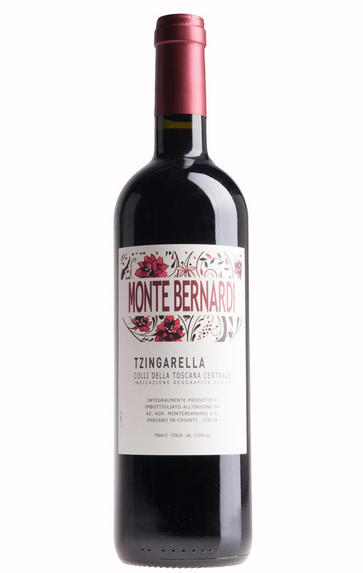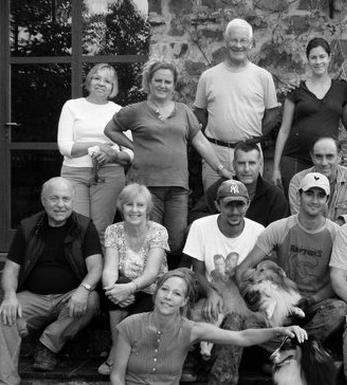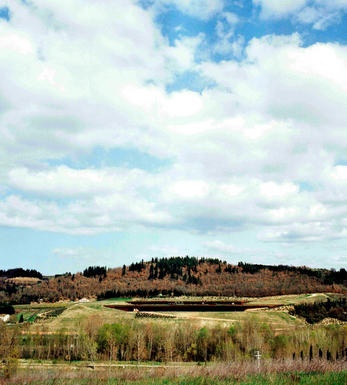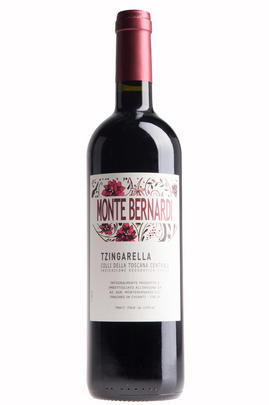
About this WINE

Monte Bernardi
The estate was originally purchased in 1988 by Stak & Sharon and the first wine was produced in 1992. The Schmelzer family acquired Monte Bernardi at the end of 2003 and they are now building on what Stak successfully started, investing money in both the vineyards and the winery.
The Monte Bernardi estate extends over 52 hectares (130 acres), of which 15 hectares and 5 of those hectares are old vines of 45+ years. The vineyards are situated in the hilly, southern most region of Panzano, an area that has been acknowledged as one of the Grand Cru of Chianti Classico, and is considered capable of making wines that can compete with the best in the world. The vines are planted on a soil of a high rock content mixture, which dependent on the vineyard consists of shale (Galestro), marl and limestone (Alberese).
The vineyards are perfectly situated - standing at an altitude of 350 meters above sea level, surrounded by forests and enjoying a southern exposure, with the river Pesa flowing just a few hundred meters to the south. These factors contribute to the unique micro-climate of Monte Bernardi.

Chianti Classico
Chianti Classico is a leading Tuscan DOCG zone which covers approximately 7,000 hectares between Florence and Siena. Its vineyards stretch into the Apennine foothills at altitudes of between 150m and 500m, and encompass two distinct terroirs and styles. The sandy, alluvial soils of the lower sites yield fuller, meatier wines while the limestone and galestro rocks of the higher vineyards deliver finer, more ethereal examples.
The origins of Chianti date back to the Middle Ages, although Chianti Classico was really born in 1716 when Grand Duke Cosimo III of Tuscany classified the zone, identifying the villages of Radda, Greve, Panzano, Gaiole and Castellina as the leading sites; these same villages still represent the nucleus of the Chianti Classico DOCG today. The regulations have been revised, however, to insist that the wine is made from a minimum 80 percent Sangiovese and a maximum 20 percent Canaiolo and ameliorative grapes (ie Merlot and Cabernet Sauvignon); from the 2006 vintage, no white grapes are allowed.
Chianti Classico cannot be released until 1st October in the year following the harvest, while Chianti Classico Riserva must undergo 24 months of ageing before release, including at least three months in bottle. At the region’s top addresses, French barriques are gradually being adopted in the place of the traditional, larger slavonian botte.
Recommended Producers: Monte Bernardi, Tenuta Fontodi, Castelo di Ama, Bibbiano

Merlot
The most widely planted grape in Bordeaux and a grape that has been on a relentless expansion drive throughout the world in the last decade. Merlot is adaptable to most soils and is relatively simple to cultivate. It is a vigorous naturally high yielding grape that requires savage pruning - over-cropped Merlot-based wines are dilute and bland. It is also vital to pick at optimum ripeness as Merlot can quickly lose its varietal characteristics if harvested overripe.
In St.Emilion and Pomerol it withstands the moist clay rich soils far better than Cabernet grapes, and at it best produces opulently rich, plummy clarets with succulent fruitcake-like nuances. Le Pin, Pétrus and Clinet are examples of hedonistically rich Merlot wines at their very best. It also plays a key supporting role in filling out the middle palate of the Cabernet-dominated wines of the Médoc and Graves.
Merlot is now grown in virtually all wine growing countries and is particularly successful in California, Chile and Northern Italy.



Buying options
Add to wishlist
Description
Monte Bernardi is situated in the heart of the Conca d’Ora of Panzano. Trailblazing owner Michael Schmelzer produces some of Tuscany’s greatest wines, combining ancient methods, a modern outlook and some of Chianti’s best terroir. Grown from organic vines, Tzingarella is his nod to the Super Tuscans. With 18 months in mixed wood, this full of international appeal yet distinctly Tuscan. The nose is full of vivid cassis and wild spices. The palate is gentle but intense, with cherry-laden fruit and bags of crunchy berries, with a saline, mineral grip.
Drink now to 2030.
Davy Zyw, Senior Buyer (October 2020)
wine at a glance
Delivery and quality guarantee